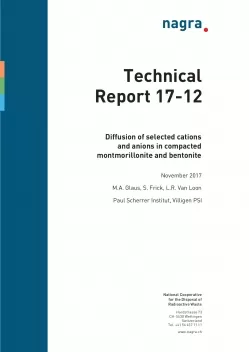
Technical Report NTB 17-12
Diffusion of selected cations and anions in compacted montmorillonite and bentonite
The present report gives a summary of the experimental results obtained from various diffusion experiments with positively and negatively charged radiotracers, including HTO as a neutral reference species, in compacted homoionic Na-montmorillonite and a natural bentonite. The purpose of the report is to document the results, the experimental methods and modes of data evaluation and further to test these data for internal consistency and propose simplified ways for their application in the safety analysis of a deep geological repository for radioactive waste.
The diffusion experiments comprised HTO, 22Na+, 85Sr2+, 134Cs+, 36Cl–, 35SO42– and 75SeO42– as the radiotracers and were carried out at bulk dry densities between 1300 and 1900 kg m‑3 and using background electrolyte concentrations between 0.1 and 1.0 M for the contacting liquid phases. Through-diffusion was the basic method applied to all test systems. In order to verify the results obtained thereby and to obtain additional information on the role of the confining filters, through-diffusion was followed either by out-diffusion or tracer profile analysis. Depending on the diffusivities in the clay specimens, diffusion cells equipped with a flushed filter system were used in order to avoid potential difficulties in the data evaluation related to the formation of concentration gradients in the confining filters. In all cases where the latter gradients were clearly less than the respective gradients in the clay samples during the steady-state flux phase, diffusion cells with static filter systems were used. Best-fit parameter values were evaluated by various methods, comprising approximate analytical solutions of the diffusion equation and inverse modelling techniques involving numerical solver procedures. In many experiments the diffusion of the charged tracer ion was simultaneously measured with the diffusion of the uncharged HTO tracer in order to increase the comparability of the break-through curves.
The results are in good agreement with our observations for bulk-dry densities of 1900 kg m‑3 published earlier. The diffusive fluxes of cationic tracers were larger than expected for a simple proportionality of the effective diffusion coefficients of the HTO tracer with the respective diffusion coefficients in bulk water. The diffusivities increased with decreasing concentration of the background electrolyte exhibiting the already observed dependency on cation charge. It can be concluded that the overall observed diffusive fluxes of cationic species are predominantly controlled by the entirety of mobile surface species, not only at the highest bulk-dry densities, but also at bulk-dry densities relevant for a realistic compaction of bentonite in the buffer and backfill materials foreseen in the disposal concept for high-level radioactive wastes. This behaviour applied basically for Na+ and Sr2+, for which surface species in the cation exchange sites (planar sites) are assumed to be the only surface species. For Cs+, for which the existence of more than a single surface species is indicated in the sorption isotherms, this behaviour was more complex. The data suggest that the different Cs+ surface species exhibit different surface mobilities.
For anionic radiotracers an inverse behaviour in diffusion was observed. The effective diffusion coefficients were lower than those predicted simply based on bulk water diffusion coefficients and decreased with decreasing concentration of the background electrolyte. This behaviour can be explained by different approaches regarding the distribution ratios of anions in bulk water and anions in the vicinity of negatively charged surfaces ("anion exclusion"). No attempts were undertaken in the present work to discriminate between the various models proposed in the literature.
The retardation of cationic species observed in the experiments with compacted clay samples were largely in agreement with predictions based on the selectivities for cation exchange obtained from measurements in dilute suspensions. No observations were made which would favour the view of reduced accessibility of sorption sites in compacted samples of clay minerals. It has rather to be assumed that the entire cation exchange capacity is available for exchange reactions. However, significant discrepancies in the sorption distribution coefficients could be observed in the case of Cs+, with a trend of increasing Cs-selectivity with increasing bulk-dry density. It was proposed already in previous work related to studies on bentonite that this phenomenon can rather be explained by the different hydration properties of this alkali cation compared to Na+. In the present work the dependencies observed for Na-montmorillonite were similar to the behaviour for bentonites, both in the transient phase of diffusion experiments and in sorption experiments with compacted clay samples. For Sr2+ a slightly decreasing Sr-selectivity with increasing bulk-dry density was observed in the experiments with compacted Na-montmorillonite. In view of the larger hydration sphere of Sr2+ compared to Na+, this observation is thus in agreement with the behaviour of Cs+, for which hydration provides less energy than for Na+.
The present work clearly shows that the migration of charged radionuclides in charged argillaceous media needs to be related to the particular chemical conditions of the equilibrium solution. The simple pore diffusion model devoid of a surface diffusion component was found to be inadequate to describe the observed behaviour. A simple model based on the "Gimmi – Kosakowski" scheme for relating the effective diffusion coefficients with sorption distribution values and the extended Archie relation used to take into account geometrical effects, is proposed here for application in safety analysis. Such applications are, however, restricted to the type of cations investigated in the present work (alkali and alkaline-earth cations). It was shown in different work from our laboratory that surface diffusion plays also an important role in the diffusion of transition elements. However, in such cases only part of the surface species is mobile and needs to be taken into account for the evaluation of effective diffusion coefficients.
